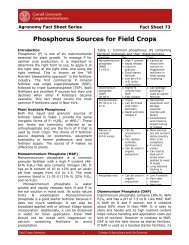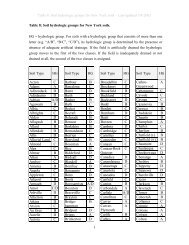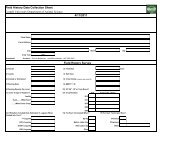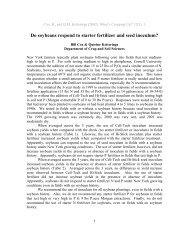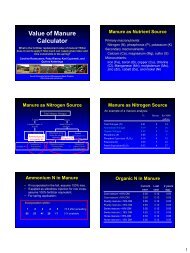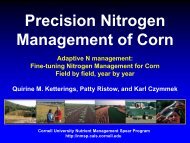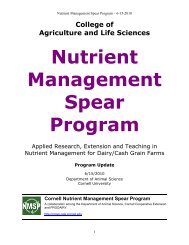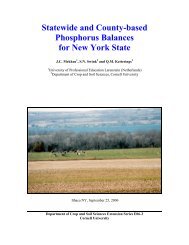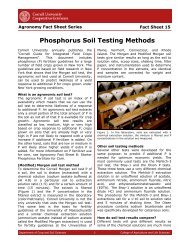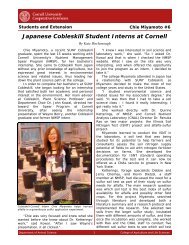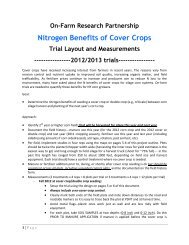Cornell Nutrient Management Spear Program - Cornell University ...
Cornell Nutrient Management Spear Program - Cornell University ...
Cornell Nutrient Management Spear Program - Cornell University ...
You also want an ePaper? Increase the reach of your titles
YUMPU automatically turns print PDFs into web optimized ePapers that Google loves.
INTRODUCTION<br />
<strong>Cornell</strong> <strong>Nutrient</strong> <strong>Management</strong> <strong>Spear</strong> <strong>Program</strong><br />
Mass <strong>Nutrient</strong> Balance Input Form Instructions<br />
March 7, 2011<br />
The purpose of this input form is to collect the necessary data for developing a whole farm mass nutrient<br />
balance. This form can be used to develop a mass nutrient balance for any type of livestock operation<br />
(dairy, swine, poultry, etc.), or for non-livestock farms. For non-livestock farms, ignore all questions<br />
concerning animals. Send completed from to: Caroline Rasmussen, 325 Morrison Hall, <strong>Cornell</strong><br />
<strong>University</strong>, Ithaca NY 14853. FAX: 607 255-9829 Attn: Caroline Rasmussen. Email: cnr2@cornell.edu.<br />
FARM CHARACTERISTICS<br />
Producer Contact Information:<br />
Record the producer contact information, including address, phone and email (if available).<br />
Data Collection:<br />
Enter the name and email address of the CCE or agency professional collecting the data (if applicable).<br />
Enter data for the calendar year January 1, 2010 to December 31, 2010.<br />
Watershed:<br />
Enter the watershed where most of the farm owned and rented land is located in the “Primary” box (see<br />
the map below). If the farm is in two watersheds, enter the watershed that has the smaller farm area in<br />
the “Secondary” box.<br />
Farm Information<br />
Total farm acres: Enter the total owned and rented farm acres (including buildings and woodlands).<br />
All legume and non-legume tillable crop and pasture acres: Enter the total number of crop and<br />
potentially tillable pasture acres owned and rented.<br />
Legume acres (perennial and annual) >10% legume: Enter all crop and tillable pasture acres, both<br />
annual and perennial that have more than 10% legume plant content.<br />
Acres receiving manure (crop and pasture): Enter the total number of acres owned and rented that<br />
receive manure either by mechanical spreading and/or animal grazing.
Enter “yes” or “no” to the questions concerning the <strong>Cornell</strong> Dairy Farm Business Summary, the Farm<br />
Credit Business Summary, organic certification, intensive grazing, having a Comprehensive <strong>Nutrient</strong><br />
<strong>Management</strong> Plan (CNMP) and having a <strong>Cornell</strong> Cropware Plan.<br />
Animal Information<br />
Enter the average number and weight per head of animals on the farm during the balance year. On dairy<br />
and beef farms, group all mature cows (milking and dry) on the first line. These are cows that have<br />
freshened one or more times. This information is used to calculate total animal units (AU). An animal unit<br />
is equal to 1,000 lbs live weight. The total animal units are the combined weight (lbs) of all animals<br />
divided by 1,000.<br />
FARM CROP PRODUCTION<br />
Record all crop and pasture production. Include crops grown for feed and for off-farm sale. Enter the<br />
percent legume in the stand. If a legume % greater than 0 is entered, check the box if manure was also<br />
spread (mechanically or by grazing livestock) on the same acreage. Enter the number of acres, the crude<br />
protein (CP), phosphorus (P) and potassium (K) content of the harvested crop (% dry matter). Select<br />
“forage”, “grain” or “Bedding” to describe the harvested crop. If you choose to enter the yield and<br />
inventory balances as dry matter, you can enter 100% in the DM% cell. If you will enter the yield per acre<br />
and inventories in as-fed tons, enter the harvested crop dry matter content as a percentage. If there is a<br />
change in the beginning and ending calendar year inventory of a crop produced for feed or sale, record<br />
the beginning and ending year inventory. Enter the average yield in tons (dry matter or as-fed, as<br />
selected in the previous column) per acre. If you enter the yield on a dry matter basis, also enter<br />
beginning and ending year inventories on a dry mater basis. If you entered the yield on an as-fed basis,<br />
enter the inventory on the same as-fed basis.<br />
If crop production records are not available, the quantity harvested can be estimated as shown below.<br />
Keep in mind, the shrink_fraction is the percent shrink entered as a fraction. All other inputs are in tons.<br />
Quantity harvested =<br />
[Beginning_inventory + (daily_feed_out * days_since_harvest) – current_inventory] * [1 + shrink_fraction)<br />
Harvested Yield = Quantity harvested / Acres harvested<br />
NUTRIENT IMPORTS<br />
Feeds Purchased:<br />
Record the type of feed, tons purchased per year, and the percentages of dry matter, crude protein, P,<br />
and K. Select the feed type: “Grain”, “Forage” or “TMR”. The "% forage" is only entered when TMR is<br />
selected. If there is a change in the beginning and ending calendar year purchased feed inventory, record<br />
the beginning and ending year inventory in tons as-fed.<br />
Purchased fertilizers:<br />
Record the fertilizer type, tons purchased per year, and the percentages of N, P 2 O 5 , and K 2 O.<br />
Purchased animals:<br />
Record the number of adults and young stock purchased, and the average weight per head in lbs.<br />
Bedding and miscellaneous imports:<br />
Record the number of tons, percent dry matter, N, P and K (% dry matter) for all bedding material<br />
purchased or other miscellaneous imports. Do not enter farm produced bedding.<br />
NUTRIENT EXPORTS<br />
Milk sold:<br />
Enter the annual total amount of milk sold (in lbs) and the average percent milk protein, as reported on<br />
the milk check.<br />
Animals exported:<br />
Enter the number and average live weight per head of all animals sold or exported from the farm.
Crops sold:<br />
Enter the type of crop sold, its quantity, and the percentages of dry matter, crude protein, P (% dry<br />
matter) and K (% dry matter). If a total mixed ration is sold, enter the proportion of the mix which is forage.<br />
Manure, compost and other exports:<br />
Record any other significant products that were sold or given away, such as manure, compost, etc. Enter<br />
the quantity, and % solids. Enter the N, P and K on a wet basis as this is the format that compost and<br />
manure analysis is commonly reported.



